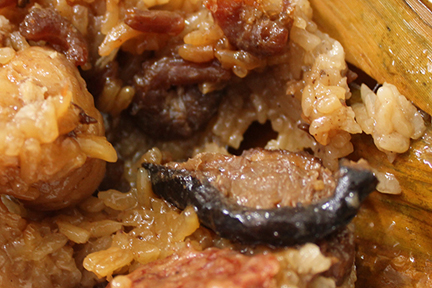Zongzi (sticky rice dumplings) are traditionally eaten during the Duanwu Festival (Mandarin: Duānwǔ; Cantonese: Tuen Ng), which falls on the fifth day of the fifth month of the lunar calendar (approximately late-May to mid-June).
A popular belief amongst the Chinese of eating zongzi involved commemorating the death of Qu Yuan, a famous Chinese poet from the kingdom of Chu who lived during the Warring States period. Known for his patriotism, Qu Yuan tried unsuccessfully to warn his king and countrymen against the expansionism of their Qin neighbors. When the Qin general Bai Qi took Yingdu, the Chu capital, in 278 BC, Qu Yuan's grief was so intense that he drowned himself in the Miluo river after penning the Lament for Ying. According to legend, packets of rice were thrown into the river to prevent the fish from eating the poet's body.
Although it may have originally been a seasonal food, zongzi are available year-round in most major cities with a significant Chinese population.
- "Jiaxing zongzi" (嘉兴粽子): It is one famous kind of zongzi in mainland China named after the city Jiaxing. The filling is typically pork but also can be mung beans, red beans or salted duck eggs.
- Jia zong (假粽): Instead of glutinous rice, balls of glutinous rice flour (so no individual grains of rice are discernible) are used to enclose the fillings of the zongzi. These zongzi are typically smaller than most, and are much stickier.
- Jianshui zong (碱水粽): Meaning "alkaline water zong," these are typically eaten as a dessert item rather than as part of the main meal. The glutinous rice is treated with lye water (aqueous sodium hydroxide), or potassium carbonate, giving them their distinctive yellow color. Jianshui zong typically contain either no filling or are filled with a sweet mixture, such as sweet bean paste. Sometimes, a certain red wood sliver ( 蘇木 ) is inserted for color and flavor. They are often eaten with sugar or light syrup.
- Nyonya Bak Chang / Nyonya zong (娘惹粽): A specialty of Peranakan cuisine, these zongzi are made similarly as southern zongzi. However, the filling is typically minced pork with candied winter melon, ground roasted peanuts, and a spice mix.
- Taiwan zongzi (臺灣粽): The northern Taiwanese zongzi (北部粽) are wrapped with husks of "Phyllostachys makinoi" bamboo (桂竹籜), then steamed; southern Taiwanese zongzi (南部粽) are wrapped with leaves of Bambusa oldhamii (麻竹葉), then boiled.
- Filipino Machang is a Filipinized version of zongzi,common in Chinoy (Chinese Filipino) communities.

- Eastern Rice Dumpling 东园肉粽 - 300 Balestier Road
- Eastern Rice Dumpling 东园肉粽 - Bedok Mall #B2-K10
- Eastern Rice Dumpling 东园肉粽 - Tampines One #B1-K6
- Hiong Kee Dumplings 香记肉粽 - Hong Lim Food Centre #02-37
- Hoo Kee Bak Zhang 和记肉粽 - Amoy Street Food Centre #01-18
- Kim Choo Kueh Chang 金珠肉粽 - 60 Joo Chiat Place
